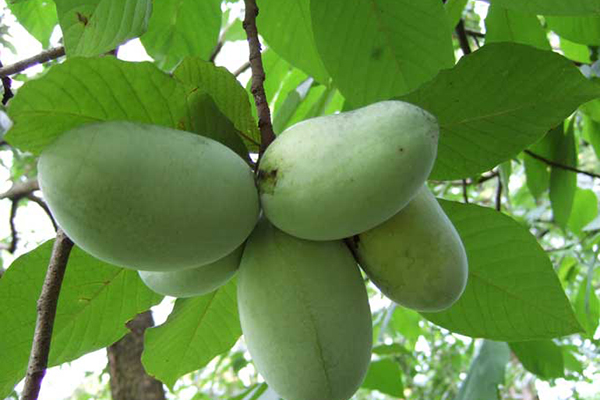By Suzanne Wodek, Asheville Botanical Gardens
 The pawpaw (Asimina triloba) is native to North America and grows wild in much of the Eastern and Midwestern portions of the United States. The earliest mention of papaws in cultivation was in 1541 when explorer Hernando de Soto reported the cultivation of the trees by Native Americans. Chilled papaw fruit was a favorite dessert of George Washington and Thomas Jefferson planted these trees at his Monticello home.
The pawpaw (Asimina triloba) is native to North America and grows wild in much of the Eastern and Midwestern portions of the United States. The earliest mention of papaws in cultivation was in 1541 when explorer Hernando de Soto reported the cultivation of the trees by Native Americans. Chilled papaw fruit was a favorite dessert of George Washington and Thomas Jefferson planted these trees at his Monticello home.
Common names for pawpaw include Custard Apple and Poor Man’s Banana. The tree produces a tropical-like fruit with a vanilla or banana/mango flavor. The ripened fruit’s soft flesh is very creamy, and the large seeds are easy to remove, making the pawpaw an excellent choice for eating right off the tree.
Pawpaws are rich in nutritional value, with high levels of vitamins A and C. The downside is that ripe pawpaws have a short shelf life, making it difficult to sell them at farmers’ markets and grocery stores.
Pawpaws grow best in slightly acidic, fertile, and well-drained soils. These trees rarely grow taller than 25 feet and, when grown in full sun, they develop a pyramidal shape, with dense, drooping foliage. In the shade, they have a more open branching habit. Because pawpaws grow clonally, meaning that they shoot up sprouts around the main trunk and form a colony of little trees, it is best to use container-grown transplants. Because this tree has few pests, it can be grown organically with little effort.
The maroon-colored flowers produce a rather fetid odor similar to that of rotting meat. But the smell is important because it attracts blowflies and carrion beetles necessary for pollination. Interestingly, pawpaw growers often put roadkill or other rotting meat in their groves to attract pollinators.
The foliage is the sole food source for the Zebra Swallowtail caterpillar, and the butterflies are attracted to pawpaw trees as a result. Deer on the other hand are not interested in eating the tree’s leaves.
The “Pawpaw Tree Incident” between the Hatfield and the McCoys is detailed on a plaque alongside a highway in Kentucky. It tells the story of three McCoy brothers captured by the Hatfield clan. They were tied to pawpaw trees and shot to death.
On a considerably lighter note, who can forget the pawpaw song that asks where is Susie, to which the answer is: Picking up pawpaws, put ‘em in a basket. Way down yonder in the pawpaw patch.
The Botanical Gardens (ashevillebotanicalgardens.org), located at 151 W.T. Weaver Boulevard, is a nonprofit organization housing a collection of plants native to the Southern Appalachian Mountains. Admission is free, but donations are appreciated. Check the website for this month’s Educational Programs.






